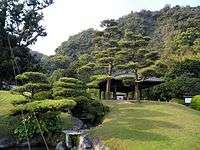Sengan-en

Sengan-en (仙巌園) is a Japanese garden attached to a former Shimazu clan residence in Kagoshima, Kagoshima Prefecture, Japan. Designated a Place of Scenic Beauty, together with the adjacent Shōko Shūseikan it forms part of the UNESCO World Heritage Site Sites of Japan’s Meiji Industrial Revolution: Iron and Steel, Shipbuilding and Coal Mining.[1][2][3]
History
The Sengan-en residence was built by Shimazu Mitsuhisa (島津光久) in 1658. The name is derived from a supposed resemblance to an eponymous feature on Long Hu Shan.[3] In 1736 Shimazu Yoshitaka (島津吉貴) added a kyokusui (曲水) water feature and moso bamboo, obtained from China via the Ryūkyū Kingdom.[2] During the Bakumatsu and Meiji periods, the residence housed visiting dignitaries including Katsu Kaishū, Willem Huyssen van Kattendijke, and Pompe van Meerdervoort in 1858, Harry Smith Parkes in 1866, Tsesarevich Nicholas Alexandrovich and Prince George of Greece in 1891, and the Duke of Connaught and Strathearn in 1906.[3]
Gardens
The gardens incorporate the view of Sakurajima across Kagoshima Bay as borrowed scenery.[3]
See also
References
| Wikimedia Commons has media related to Sengan-en. |
- ↑ 仙巌園 附 花倉御仮屋庭園 [Sengan-en and Kekura Okariya Gardens] (in Japanese). Agency for Cultural Affairs. Retrieved 17 October 2015.
- 1 2 仙巌園 附 花倉御仮屋庭園 [Sengan-en and Kekura Okariya Gardens] (PDF) (in Japanese). Kagoshima Prefecture. Retrieved 17 October 2015.
- 1 2 3 4 "Nomination File". UNESCO. p. 829. Retrieved 17 October 2015.
External links
- (English) Sengan-en and Shoko Shuseikan
- (English) Map of Sengan-en
Coordinates: 31°37′05″N 130°34′43″E / 31.618048°N 130.578502°E